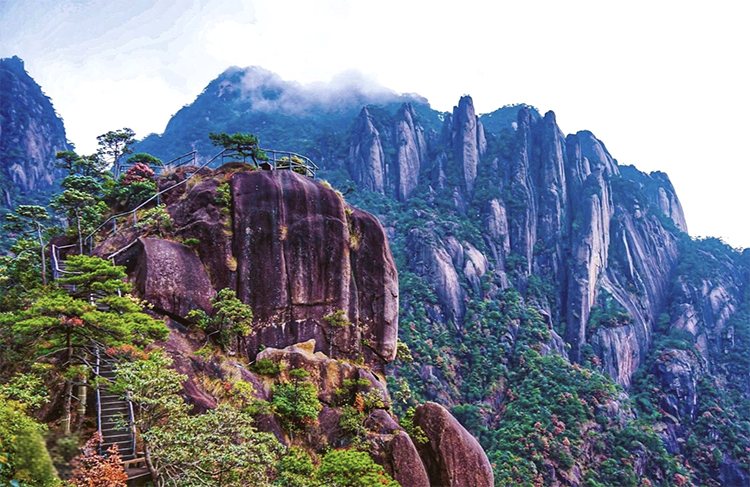Explore Mount Sanqing’s Granite Peaks: China’s Majestic Taoist Sanctuary
Introduction: A Mist-Wrapped “Fairyland”
Hidden among the mountains of Shangrao in Jiangxi province, Mount Sanqing (Sanqing Mountain) is celebrated as the “First Immortal Mountain under Heaven.” Towering granite peaks, drifting clouds, and ancient pine forests create scenes like a living ink painting. A UNESCO World Natural Heritage site and one of the world’s most valuable geoparks, Mount Sanqing draws visitors with its unique granite peak forest, millennium-old Taoist legacy, and dramatic seasonal scenery. Whether you stroll the 1,600 m cliffside walkways or explore Ming-dynasty Taoist halls, the mountain offers both spiritual calm and spectacular natural drama.
1. World-class granite wonder: Nature’s masterpiece
Mount Sanqing’s most striking feature is its magnificent granite peak forest, praised by geologists as some of the most beautiful granite on the western Pacific margin. The peaks take on sculptural forms, as if carved by an artist:
– “The Eastern Goddess” and “Giant Python Emerges”: Two iconic formations—one resembling a seated goddess, the other a python breaking through the earth—are instantly recognizable.
– 48 anthropomorphic stones: Beyond the goddess and python, the park offers named formations such as “Monkey King Offers Treasure” and “Old Taoist Worships the Moon,” each a testament to nature’s creativity.
– Nanqingyuan “West Coast” plank walk: This 4-kilometer high-altitude viewing corridor clings to cliffs at about 1,600 meters. Walking here, you tread above sheer drops with a rolling sea of clouds ahead—one of China’s most dramatic suspended walkways.
2. Millennia of Taoist culture: Tracing the Three Pure Ones
Mount Sanqing is not only a geological wonder but also a revered Taoist mountain. Its name refers to the Three Pure Ones (Sanqing)—Yuqing, Shangqing, and Taiqing—while the main summit, Yujing Peak, rises to 1,819.9 meters and symbolizes the mountain’s sacred status.
– Ming-dynasty Sanqing Palace: This well-preserved Taoist complex is built into the slopes, embodying the Taoist ideal of harmony between heaven and humanity. Stone carvings, murals, and the temple layout reflect ancient religious art and philosophy.
– Legends and history: Folktales tell of the Eastern Jin alchemist Ge Hong refining elixirs here, and generations of Taoist practitioners have cultivated the mountainside, leaving a veil of myth and ritual. Wandering the old halls, you can almost hear the echoes of centuries-old chants.

3. Four-season spectacle: Scenic highlights year-round
Mount Sanqing offers distinct charm in every season:
– Spring (April–May): Mountain rhododendrons explode into color—especially the vast Rhododendron Valley—painting slopes in pinks and reds.
– Summer (June–August): A cool refuge from the heat, with mist and cloud seas creating a fairy-tale atmosphere.
– Autumn (September–November): Forests blaze with autumn color; red leaves contrast dramatically with the granite peaks.
– Winter (December–February): After snowfall, the mountain is transformed into a monochrome ink landscape, with snow-draped pines and crystalline scenes.
4. An ecological treasure: 88% forest coverage
Mount Sanqing remains remarkably pristine, with about 88% forest coverage and rich biodiversity:
– Ancient and notable trees: Millennia-old ginkgo, Chinese yew, and other venerable trees are scattered across the mountain, bearing witness to time.
– Rare wildlife: Species such as the yellow-bellied tragopan and the white pheasant inhabit these forests; lucky visitors may glimpse them in remote areas.
5. Travel guide: How to make the most of Mount Sanqing
Transport
– High-speed rail / flights: Arrive in Shangrao city first, then transfer to the park shuttle bus (about 1.5 hours) to reach the mountain.
– Self-drive: From Nanchang or Hangzhou the drive takes roughly 3–4 hours.
Suggested routes
– One-day highlights: Nanqingyuan (Eastern Goddess, Giant Python) → West Coast plank walk → Sunshine Coast → Sanqing Palace.
– Two-day deep dive: Day 1 — Nanqingyuan and the West Coast; Day 2 — Sanqing Palace and Rhododendron Valley (spring recommended).
Tickets and opening hours
– Entry fee: CNY 245 (includes park shuttle bus).
– Opening hours: 07:30–17:30 (may be extended in peak season).
Who should go
– Physically fit travelers: Some trails are demanding, though cable cars (Jinsha and Waishuangxi lines) ease the ascent.
– Photographers: Sunrise, cloud seas, and sculpted rocks offer outstanding photo opportunities.

6. Practical tips
– Best seasons: April–May (rhododendron season) and October–November (autumn colors).
– Where to stay: Mountain hotels and local guesthouses are available—spending a night is recommended to catch sunrise and the cloud sea.
– Food suggestions: While the park offers simple meals, try local specialties in nearby Wuyuan—such as lotus-wrapped red carp and Sanqing bamboo shoots.
Conclusion: A must-visit immortal peak
Mount Sanqing combines geological wonder, Taoist heritage, and pristine ecology into a UNESCO-protected sanctuary. Whether you are an avid hiker seeking dramatic cliffs and clouds, a cultural traveler drawn to ancient temples, or a photographer chasing seasonal scenes, Mount Sanqing promises moments of awe and serenity. Let its misty peaks and storied stones be part of your journey through China’s most enchanting landscapes.


